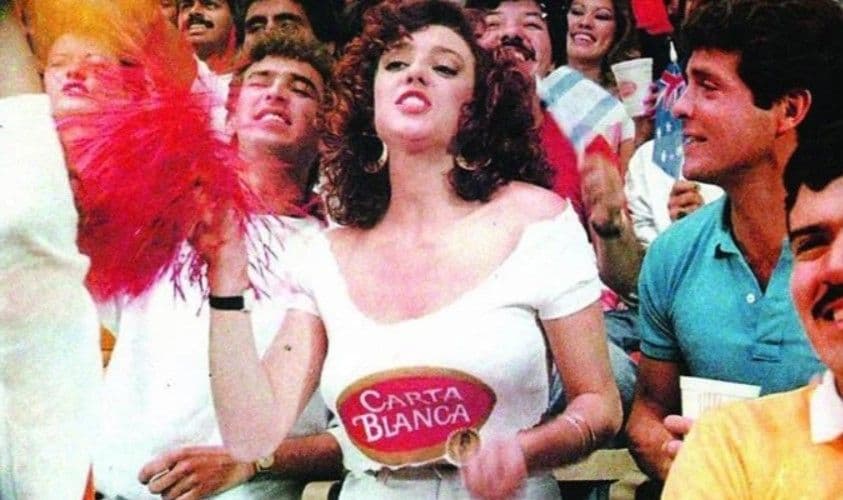November 29, 2022
•
5 min read
Chiquitibum: How A Model Popularized Mexico’s Most Famous Cheer
In this article, you'll learn about how Mexico's most-famous cheer was popularized by a model during the 1986 World Cup. Click here to learn more!
Rafael Bracho
Insurance Expert

Chiquitibum
How A Model Popularized Mexico’s Most Famous Cheer
Maybe you’ve seen it at a Mexican football game or on Mexican television, but Mexico’s famous cheer has a surprisingly quirky history and an origin that is steeped in legend. In case you have never heard it, it goes like this:
Chiquitibum a la bim bom ba,
Chiquitibum a la bim bom ba,
A la bio,
A la bao, A la bim bom ba,
Mexico, Mexico, ra ra ra!
Of course, if you are watching a Mexican football match, then in place of Mexico you would say the name of your Mexican team. It can be used in several different instances. During the Netflix documentary 1994 (about the political turmoil in Mexico during 1994), they show clips of the people chanting:
Chiquitibum a la bim bom ba,
Chiquitibum a la bim bom ba,
A la bio,
A la bao, A la bim bom ba,
Colosio, Colosio ra ra ra!
Therefore, it can be said that Chiquitibum is appropriate in any sort of competition—not only in a sports context. However, the origin of this Mexican cheer is clearly from football (soccer).
Chiquitibum
The Origin of Mexico’s Cheer
Tracking down the origin of Chiquitibum was not a simple task. Little is written on the subject—and absolutely nothing was found in English. Where one website attributes the origin of Chiquitibum to 1916, another website attributes the origin to 1923, and a third website places the origin in 1926—yet the tale remains fairly similar.
As the legend goes, at that point, Mexico was lacking its own national cheer. All the cheers were rehashing of English and American cheers, such as “Hip Hip Hooray!” Some of these were brought over directly from the Cornish miners who introduced football to Mexico.
The story is steeped in myth, however it follows that a footballer named Carlos Garcés spurred the birth of Mexico’s cheer. After El América won the national league, they were on a train to Guatemala for a game when they decided to create a Mexican cheer. Carlos noticed the sound the train makes and crafted an onomatopoeia for the sound: Shi-ki-ti, shi-ki-ti. . .
The whole team became involved in creating the Mexican cheer, and soon enough they had a basic rhythm:
Shikitibum a la bim, bom, ba,
América, América,
Ra, ra, ra!
Over the years, as legend has it, the B-section containing the other part was added:
A la bio,
A la bao,
A la bim, bom, ba
In addition, as the decades passed, Shikitibum eventually changed to Chiquitibum, and the Mexican cheer was born.
Chiquitibum
How a Model in 1986 Popularized Mexico’s Cheer:
Chiquitibum would continue to grow as a Mexican phenomenon, however, it wasn’t until Mexico hosted the 1986 World Cup that it would be popularized throughout the world. It all happened through a quirk of fate.
During the 1986 World Cup, A popular Mexican beer company called Carta Blanca released a commercial with the Chiquitibum cheer in the background. In only a couple of scenes, among a massive crowd, a buxom model grabbed the world’s attention through the provocative manner in which she danced. Overnight, this Spanish model from Málaga—named Mar Castro—became a global sensation.
*To view the original commercial, click here.
Mar Castro came to be known as the La Chica Chiquitibum, and it launched her to her 15 minutes of fame—to levels which we could all hope to attain if we should ever be graced with such a moment. She says, “Doing that commercial changed my life.”
She would end up traveling with Carta Blanca to help promote the brewery—completely sponsored by the brewery. Afterward, she moved to Los Angeles to study and pursue a career in acting. She found smalls roles in a few movies—the most famous being Love and Basketball. She settled in Los Angeles directing a production house, all while working on her true passion: poetry. In addition, she would form a band called Azul, Selah, y El Chicano where she would sing as the lead singer.
And through her 15 minutes of fame, she would bring the focus of the world’s eye onto Mexico’s cheer. Chiquitibum would come to be known throughout the world, not only as emblematic in Mexico.
Even today, that commercial continues to associate Carta Blanca with the Chiquitibum cheer. As recently as 2018, Carta Blanca released a type of “reboot” of the commercial, with a new buxom model dancing to the Mexican cheer Chiquitibum.
*To see the reboot commercial, click here.
Rafael Bracho
Insurance Expert & Writer
For several years, Rafael has been crafting articles to help expats and nomads in their journey abroad.
Get Protected While Living Abroad
Found this article helpful? Make sure you have the right insurance coverage too. Get instant quotes for international health, life, and travel insurance.
Takes 2 minutes • Compare multiple providers • Expert advice

